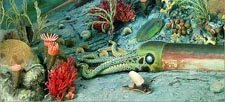 |
 |
 |
 |
 |
Produced
by the Population Genetics and Evolution class, Furman University |
||||
 |
 |
 |
 |
 |
Produced
by the Population Genetics and Evolution class, Furman University |
||||
 |
The
Ordovician: Orthoceras |
 |
||
| Orthoceras
is an extinct genus of nautiloid cephalopod. They possessed slender, elongated,
conical shells (Wikipedia 2010). The body of the organism dwelled in the
last open segment of the shell, and when they grew out of that segment
a dividing wall, or septa, grew between the new and old compartment (Mann
and Mann 2005). Inside the shell, the siphuncle expands the length of
the shell and served two purposes: (1) to store water for emergency propulsion,
and (2) to allow the animal to regulate its buoyancy (Mann and Mann 2005).
They are the earliest ancestors of modern squid and could both swim and
crawl. They range in sizes from mere inches to several feet (Mann and
Mann 2005). "Orthocones" (straight shells) are relatively common
fossils, found all over the world in marine deposits of Ordovician to
Triassic age (Wikipedia 2010). Specific sites such as Morroco, Scandinavia,
the Alps, and Iowa possess the most well-known and studied examples of
these organisms (Wikipedia 2010). However, recent analyses distinguish
several genera and Orthoceras is restricted to the type specimen
of the Ordovician. Page by Matt Medlin |
 |
| Artistic depiction of Orthoceras. From: Vertebresfossiles.com | |
|
Wikipedia. 2010. Orthoceras.Accessed Feb 2010. Mann D., Mann C. 2005. Ancient Mullusk, the Orthoceras, Grew Feet Out of its Head! Fossils-facts-and-finds. Accessed Feb 2010. |